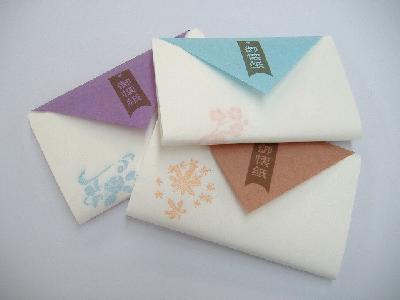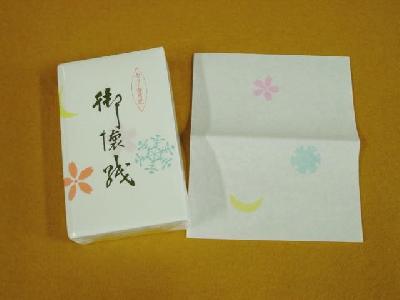懐紙 Kaishi Kaishi Paper
|
Kaishi is Japanese tissue paper folded and tucked inside the front of one’s kimono, used especially for writing poems or letters or for placing sweets, cleaning the edge of a tea bowl and so on at the tea ceremony. It is also called “Futokoro-gami” or “Tatougami.”
Kaishi paper dates back to the early 7th century, when paper making technology was introduced to Japan from China. It became widely used in the Heian period (794-1192), when the Kokufu Bunka (Japan’s original national culture) developed and writing waka (classical court poems) and other forms of poems became popular among the noble class. In the Edo period (1603-1868), Kaishi paper was indispensable article for tea ceremony.
Kumano Kaishi and Yoshino Kaishi are famous as traditional handicraft today. Kaishi paper with various patterns such as cherry blossoms, plum flowers or autumn leaves is sold now. It is not only used for tea ceremony or writing poems but also used for many purposes such as wrapping gifts or serving sweets. Kaishi paper is a Japanese wisdom, which meets the trend of ecological consciousness today.
Kaishi paper dates back to the early 7th century, when paper making technology was introduced to Japan from China. It became widely used in the Heian period (794-1192), when the Kokufu Bunka (Japan’s original national culture) developed and writing waka (classical court poems) and other forms of poems became popular among the noble class. In the Edo period (1603-1868), Kaishi paper was indispensable article for tea ceremony.
Kumano Kaishi and Yoshino Kaishi are famous as traditional handicraft today. Kaishi paper with various patterns such as cherry blossoms, plum flowers or autumn leaves is sold now. It is not only used for tea ceremony or writing poems but also used for many purposes such as wrapping gifts or serving sweets. Kaishi paper is a Japanese wisdom, which meets the trend of ecological consciousness today.
- name
- Kaishi Paper














